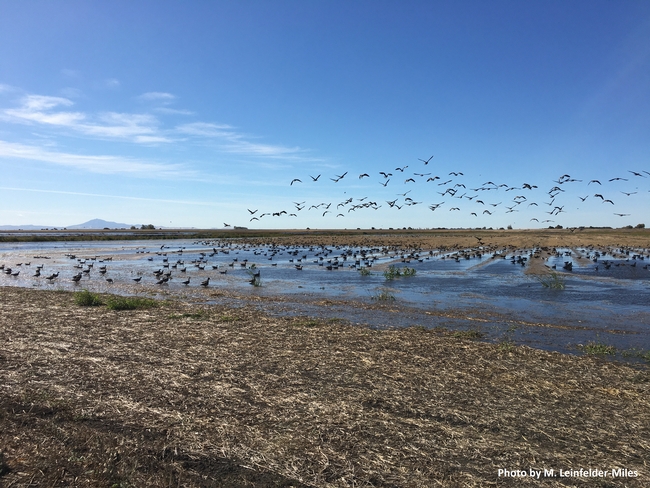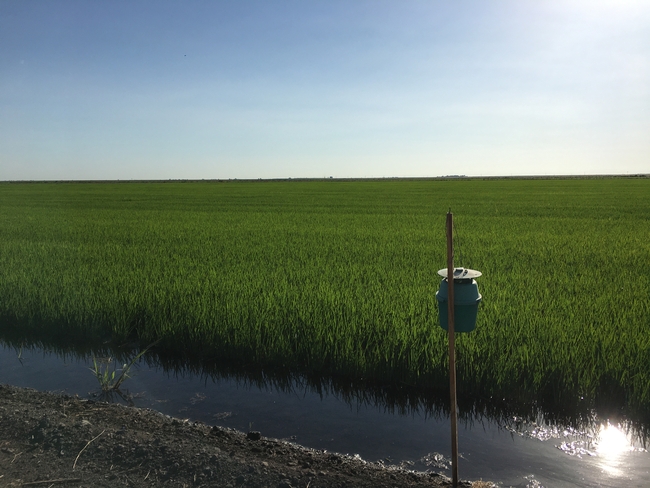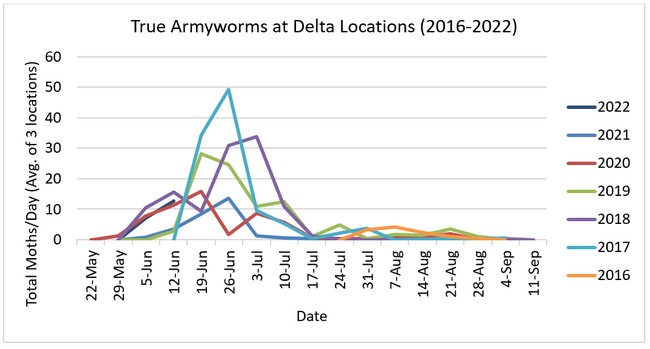- Author: Michelle Leinfelder-Miles
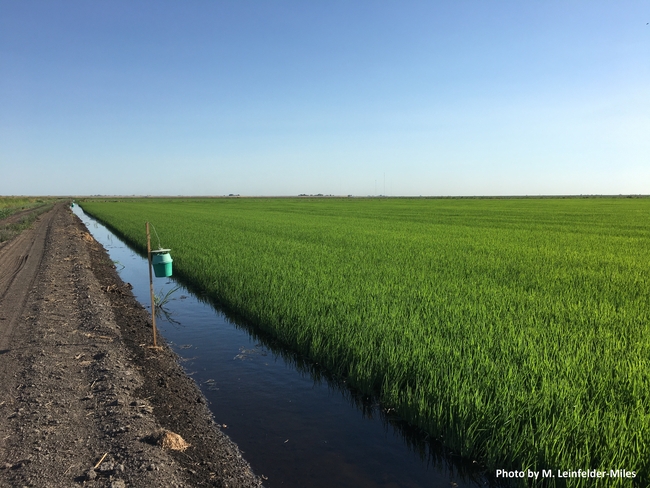
We can use trap counts and Growing Degree Day modelling (i.e. a temperature measure of time) to determine whether and when to treat fields. UC IPM provides treatment guidelines that include damage assessment and signs of the worms in the field. Earlier this year, Methoxyfenozide (Intrepid 2F) received full registration, so we now have a new tool in the toolbox when treatment is necessary.
The monitoring that I do in the Delta is part of a larger effort that is spearheaded by my colleague, Luis Espino, rice advisor in Butte and Glenn counties. Luis writes a weekly blog to provide real-time information on trap counts to help growers and consultants with scouting and decision making. In his blog announcements, he will link to an interactive mapping tool called Ag Pest Monitoring, where you can view counts across trapping locations. Please consider subscribing to Luis Espino's blog, but don't hesitate to reach out to me if you'd like to discuss what is happening in the Delta.
Good luck this season, and I hope to see you in the field!

- Author: Michelle Leinfelder-Miles
In 2022, I estimate rice acreage in the Delta, south of the Yolo Bypass, was at least 8,000 acres. Most Delta rice is grown in San Joaquin County, but there is some acreage in Sacramento County. While Delta rice acreage is relatively small compared to that in the Sacramento Valley, it has been steadily increasing over the last several years (Table 1).
Table 1. Rice acreage and yield according to the San Joaquin County Agricultural Commissioner's crop reports. County rice production is predominantly in the Delta region.
Given the increasing interest in rice production among Delta growers, and the differences in production practices from the Sacramento Valley, UC Cooperative Extension and UC Davis will be releasing a cost of production report specifically for Delta rice later this year or in early 2023. A Delta rice cost study was last produced in 2007, so updating the study was long-overdue. I want to thank all the growers who participated in a focus group to update the study.
Cool temperatures can make the Delta a challenging place to grow rice. Low night-time temperatures can cause blanking, which results in empty grains. Growers are limited to using only very-early and early maturing varieties. Most of the Delta acreage was planted with variety M-206, but some growers also planted a portion of their acreage with M-105. In 2022, we continued the UCCE Delta variety trial, which will help to identify and advance cold-tolerant varieties. The Delta trial is part of a statewide network of trials, led by UC Rice Extension Specialist, Bruce Linquist, and coordinated by Staff Researcher, Ray Stogsdill. I anticipate that the statewide results will be ready in early 2023.
This year, I worked with growers and consultants on a handful of pests. Weed management is always top-of-mind for rice growers. There are limited practices and products that can control problematic weeds, and in some circumstances, the weeds may develop resistance to the herbicides that are available. If herbicide resistance is suspected, please contact me so that we can submit weed seeds for testing. We would collect the seeds in the late summer or early fall when they have matured but have not shattered. Resistance testing is overseen by UC Weed Science Extension Specialist, Kassim Al-Khatib, and takes place in greenhouses during the winter. By the following spring, we provide the grower with information on which herbicides are still working and which are not.
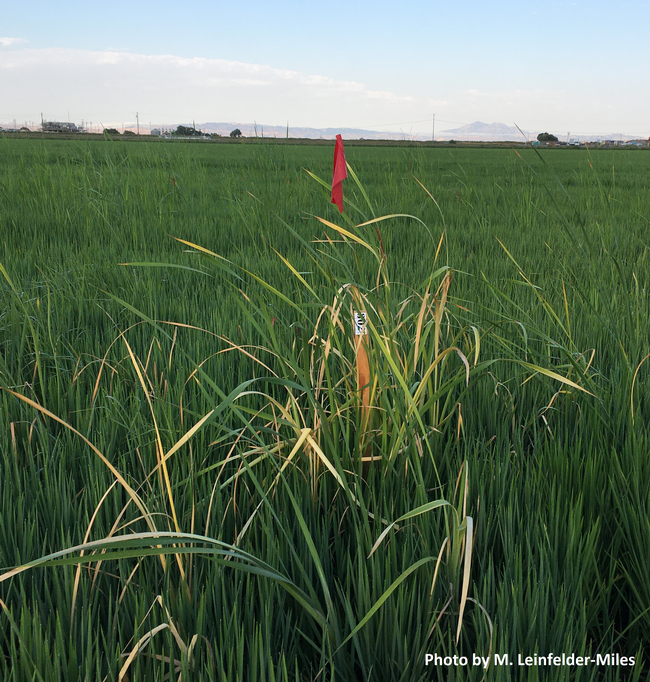
I have been trapping armyworms in the Delta since 2016, in collaboration with fellow farm advisor, Luis Espino. The traps catch true armyworm moths. They were deployed on three ranches and monitored weekly. In 2022, we recovered the highest moth counts since 2017, and the peak flight occurred about one week earlier than in 2017. This is important information for management because, based on the armyworm life cycle, we know that peak worm populations occur approximately two weeks after peak moth flight. In other words, growers can make informed decisions based on the monitoring data and adapt their management to the field conditions. Trap monitoring is one part of an integrated pest management program for armyworms, which also includes scouting for feeding damage and the worms themselves. Over the years, I have observed armyworms in riparian and wetland vegetation that neighbor rice fields, so it is important to scout those areas, too.

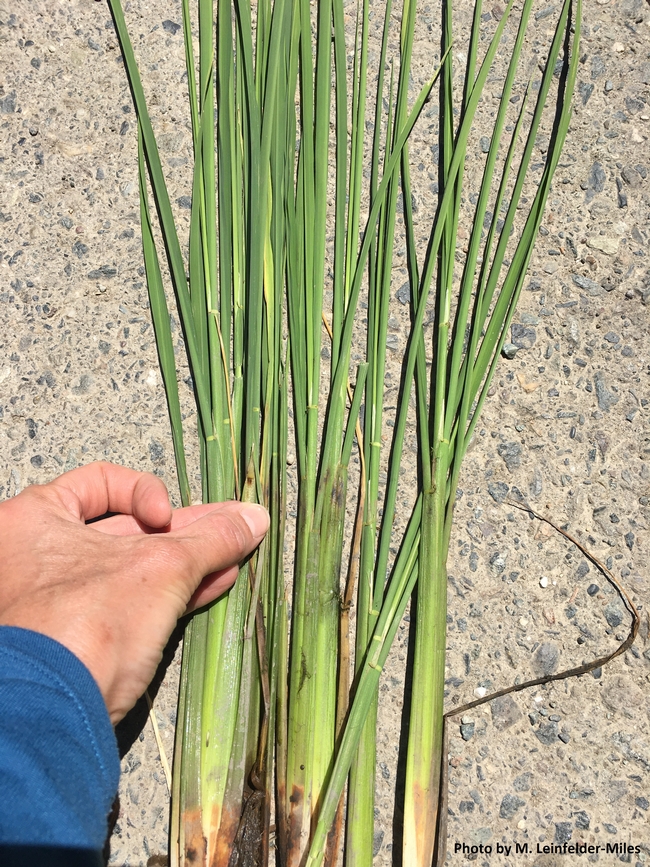
We should continue to keep weedy rice on our radars because we have seen it in the Delta in the past. Where we have observed light infestations, it appears that keen management – including in-season rogueing, post-harvest management that includes straw chopping but not incorporation, and winter flooding – can reduce, if not eliminate the pest. These are our management tools until a herbicide is approved for spot-spraying. Growers should also pay attention to equipment sanitation – harvesting weedy rice fields last (if possible) and thoroughly cleaning out equipment after harvesting fields where weedy rice has been observed.
Finally, I will be starting new projects this winter, in collaboration with fellow farm advisor, Whitney Brim-DeForest, and graduate student, Sara Rosenberg, to evaluate winter cover cropping between rice crops. Our objectives are to evaluate carbon and nitrogen cycling and variety survivability during the cool, wet (we hope!) winter conditions. These projects are supported by the CDFA Healthy Soils Program and the CA Rice Research Board. I look forward to sharing results in the years to come.
I am grateful to work with a great team of UC colleagues on these rice projects. I am also grateful for all the growers who have collaborated with us. I wish everyone a good end to the year, and I look forward to working with you again in 2023.
- Author: Michelle Leinfelder-Miles
I have been trapping armyworms in Delta rice since 2016, after the industry experienced an outbreak in 2015. Monitoring involves scouting for damage and deployment of pheromone bucket traps that catch the moths (Figure 1). I have traps at three Delta locations, and at each location, there are three traps that span adjacent fields. We can use trap counts and Growing Degree Day modelling (i.e. a temperature measure of time) to determine whether and when to treat fields. UC IPM provides treatment guidelines, and a Section 18 emergency exemption of methoxyfenozide (Intrepid 2F) has been approved for the 2022 season. (For more information, please contact your county Agricultural Commissioner's office.)
We have begun our 2022 monitoring, and trap counts are higher than they were at this same time last year (Figure 2). (Overall, 2021 was a low-pressure year.) The counts we are observing are not extreme but are on par with what we saw in 2020. It's hard to pinpoint why populations fluctuate from year to year, but it could relate to higher minimum winter temperatures (i.e. better winter survival), and/or migratory patterns from other western states and Canada.
The monitoring that I do in the Delta is part of a larger effort that is spearheaded by my colleague, Luis Espino, rice advisor in Butte and Glenn counties. Luis writes a weekly blog to provide real-time information on trap counts to help growers and consultants with scouting and decision-making. In his blog announcements, he will link to an interactive mapping tool called Ag Pest Monitoring, where you can view counts across trapping locations. Please consider subscribing to Luis Espino's blog, but don't hesitate to reach out to me if you'd like to discuss what is happening in the Delta.
Good luck this season, and I hope to see you in the field!
Figure 1. Bucket traps are placed along field edges. Nine traps are deployed across three Delta locations and are checked weekly. The traps include a pheromone lure that selectively traps true armyworm moths. (Photo by M. Leinfelder-Miles)
Figure 2. 2016-2022 Delta armyworm trap counts. The trap counts represent the number of moths caught per day, averaged across three Delta locations (9 total traps). The 2022 counts are still moderately low, averaging about thirteen moths per day during the week of June 13th, but now is the time to intensify monitoring since peak populations tend to occur between now and early July.
- Author: Luis Espino
- Author: Michelle Leinfelder-Miles
This year, with the help of Dow AgroSciences, UC farm advisors will increase the number of armyworm traps that they will monitor in rice fields. The idea is to give growers and PCAs more localized information so that they can have a better idea of what's going on near them, and when to increase their monitoring efforts. Weekly trapping numbers will be posted on the UC Rice Online website, http://rice.ucanr.edu/armyworm_traps/.
Luis Espino will be sending a weekly “armyworm alert” email once the trap numbers are updated on the website. The e-mail will go out to those who are subscribed to one of our electronic newsletters (Rice Briefs, Rice Leaf, or Field Notes). If you receive the armyworm email but are not interested, just click on the unsubscribe link at the bottom of the email. For those who do not receive our newsletters electronically, you can subscribe to the alert email in the armyworm website: http://rice.ucanr.edu/armyworm_traps/.
I will also keep you updated through this blog, specifically on Delta trap counts.
- Author: Michelle Leinfelder-Miles
Here are a few articles, written by UC Cooperative Extension colleagues, that may be of interest to readers of this blog:
From the UC Rice Blog:
Armyworm vs. High Temperature Blanking - by Luis Espino, Farm Advisor, Colusa County
From the UC Dry Bean Blog:
UC Davis Dry Bean Field Day Announcement - by Rachael Long, Farm Advisor, southern Sacramento Valley
From the UC Small Grains Blog:
Start Planning Your Nitrogen Management Strategy for Fall-Planted Wheat Now - by Mark Lundy, Small Grains Specialist, UC Davis and Konrad Mathesius, Farm Advisor, southern Sacramento Valley



